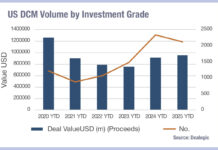
In its recent report on investment banking activity in 2020, analyst firm Coalition observed that there had been substantial growth in sell-side portfolio trading, particularly in US investment grade (IG) corporate bonds, “buoyed by increasing assets under management (AUM) in bond exchange traded funds (ETFs).”
The size of the business doubled in 2020, according to analysis from Coalition, with the average portfolio trading revenues of sell-side leaders in the business attributable to anywhere between US$250 million and US$400 million, based on definition and crossover with ETF business lines.
In 2020, the global IG market for the top 12 banks surveyed by Coalition delivered approximately US$7 billion in revenue, across secondary sales and trading. The most liquid credit market in the world, the US, mage up roughly US$4.5 billion of that total.
Portfolio trading, which includes parts of the ETF and algo trading business, delivered revenue of approximately US$1.8 billion in 2020 based on Coalition data.
“We can say about 20 to 25 percent of total IG revenues were related to portfolio trading, bearing in mind that the definition of portfolio/algo/ETF businesses is often nebulous,” says Michael Turner, head of competitor analytics at Coalition. “Amongst the top three dealers in whom this business is concentrated, they make on average US$800+ million in IG trading, and portfolio/algo trading is about US$250 million to US$400 million.”
Portfolio trading is closely associated with ETFs because it supports the creation and redemption process. By trading the full basket of bonds within the index that an ETF tracks, all of the underlying bonds can be bought or sold simultaneously.
Market makers quote two-way continuous prices on bond ETFs making the ETFs more liquid and less of a challenge to trade than the underlying indexed bonds. Many ETF market makers do not require exactly the same bonds as those indexed, due to the huge range of bonds issued at different tenors by any given company, which creates further flexibility in the bonds that can be included within a portfolio trade.
“ETF portfolio trading is all about fast pricing, risk management, very traditional electronic strengths,” says Turner. “These trades are typically non-iterative, as there is little to no negotiation.”
However, portfolio trades can also be more complex. A bank may both buy and sell some bonds within a single portfolio trade, or negotiate to trade a larger, more bespoke set of bonds.
“This other model is iterative, where you have 200+ bonds in a portfolio, and the traders go back and forth negotiating to add and remove bonds to get a better price,” he says.
Typically, the bigger banks and investment firms are, the more they can add into an iterative trade, while non-iterative trades – which make the basket more like an ETF – will be easier to then liquidate.
Banks use algorithms to price and process these trades and categorising revenues earned against portfolio trading versus algorithmic trading or even via their ETF desk is open to interpretation, hence the range of revenues that Coalition identifies within this bucket.
Given how early portfolio trading is in its evolution, its rapid adoption and considerable buy-side appetite, it could have a significant impact on the future of credit trading.
“Fifteen years ago people couldn’t give a definition of electronic FX trading with 100 per cent certainty; for US Treasuries that was true five years ago,” observes Turner. “We are at the starting point for credit, but each journey becomes a tech arms race pretty quickly. And those that have got ahead set the standards and innovate, therefore have more to lose and therefore keep investing.”
He continues, “The question many banks are asking themselves is, is this really an arms race? Is it going to evolve like US Treasuries? I don’t think it will ever get electronic as that, because it’s so fragmented. But people used to say that about US Treasuries, and FX and before that cash equities. So it’s only progressing down that direction on the flow credit side in our view.”
The challenge that many dealers will be faced with is faced with assessing which technology to invest in to optimise the process in order to support this model.
©Markets Media Europe 2025










